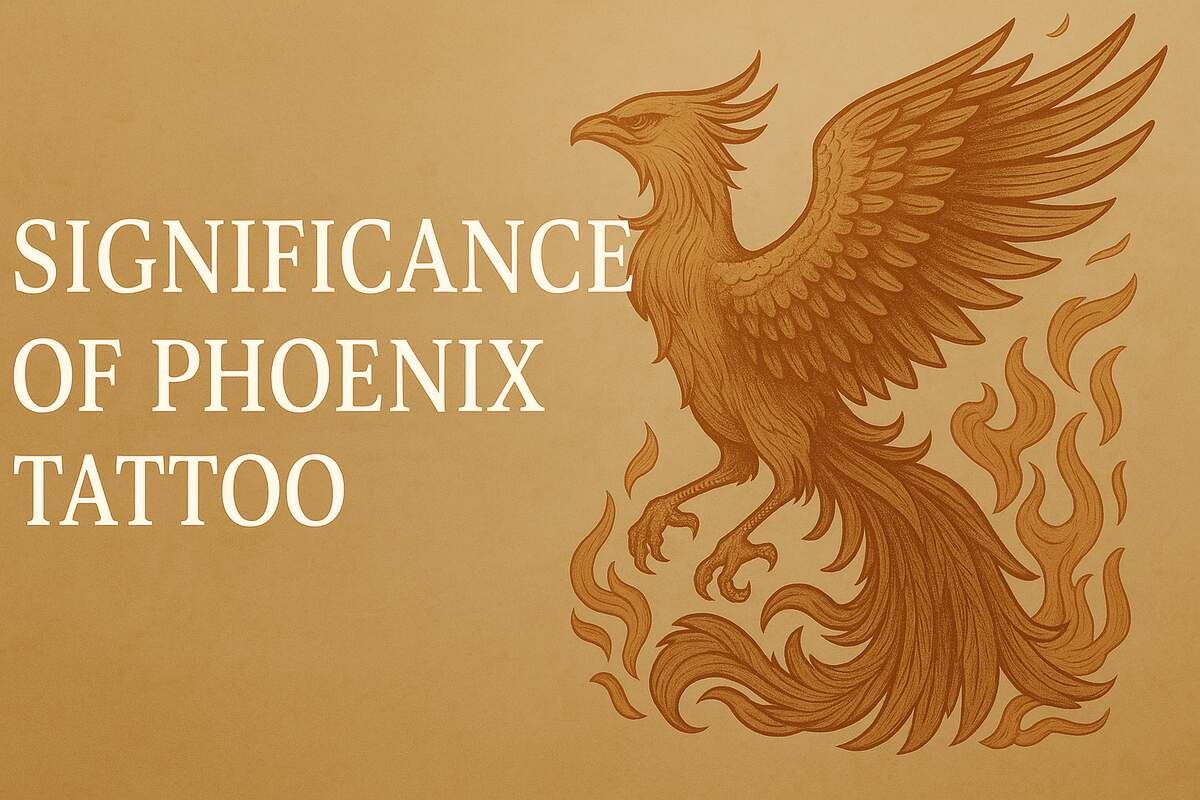Introduction
Have you noticed the stunning, fiery bird soaring across arms, backs, and social media feeds? Phoenix tattoos are exploding in popularity, captivating people worldwide. But this isn’t just a fleeting trend; it’s a powerful symbol speaking directly to the human spirit’s incredible capacity for renewal. Understanding the significance of phoenix tattoo goes far beyond admiring beautiful body art. It’s about connecting with an ancient, universal story of death and rebirth that resonates across continents and centuries.
This blog is your ultimate guide. We’ll journey deep into the heart of the phoenix legend, exploring its fiery origins and tracing its flight through diverse cultures. We’ll uncover why this mythical bird holds such potent meaning, especially for those choosing to wear it permanently on their skin. Why do people gravitate towards such powerful symbols? Often, it’s because tattoos like the phoenix become silent, personal declarations – visual reminders of battles fought, darkness overcome, and the constant potential for transformation and rebirth.
The core legend is captivatingly simple: The phoenix is a magnificent, radiant bird, often associated with the sun. After living a long life (hundreds or even thousands of years!), it builds a special nest of aromatic spices and sacred woods. Then, in a spectacular display, it sets itself ablaze, consumed by its own fire. But this isn’t the end. From the pile of cooling ashes, a new phoenix emerges – sometimes as a fledgling, sometimes fully grown – ready to live another extraordinary cycle. This powerful image of rising from the ashes isn’t confined to one culture; it’s a universal symbol found in myths and legends from ancient Egypt to the Far East and the Americas. People choose symbolic tattoos like the phoenix because they encapsulate profound personal journeys – stories of survival, hope, and the undying spark within – in a single, potent image.
The Myth of the Phoenix: From Ancient Embers to Modern Ink
What Is a Phoenix? – A Mythical Overview:
Imagine the most breathtaking bird you can: larger than an eagle, feathers shimmering in hues of crimson, gold, violet, and sapphire, radiating light like captured sunshine. This is the phoenix. Unlike ordinary birds, its life isn’t linear but cyclical. Its defining characteristic is its death and rebirth. It doesn’t simply die; it chooses a fiery, transformative end, ensuring its own renewal. It represents immortality, not in the sense of never dying, but in the sense of life perpetually renewing itself. The phoenix embodies the very essence of transformation – the idea that destruction is necessary for creation, that endings pave the way for powerful new beginnings. Its elemental connection is intrinsically tied to fire and ashes – fire for its purifying, destructive power, and ashes as the fertile ground from which new life miraculously springs.
Ancient Origins of the Phoenix Myth:
The phoenix myth has incredibly deep roots. Its earliest identifiable form is found in Ancient Egypt, dating back over 4,000 years. Here, it was known as the Bennu bird. Depicted as a grey heron or a majestic eagle-like bird (sometimes even a yellow wagtail), the Bennu was deeply connected to the sun god Ra and the life-giving flooding of the Nile River. It was seen as the soul of Ra and Osiris (god of the afterlife) and symbolized creation, resurrection, and the rising sun. The Bennu was believed to have burst into existence from a fire burning on the sacred Benben stone (associated with the primordial mound of creation) in the temple at Heliopolis (“City of the Sun”).
From Egypt, the legend traveled. Ancient Greek writers like Herodotus (5th century BC) and later Pliny the Elder (1st century AD) documented the phoenix, though their accounts varied. Herodotus described it as an eagle-sized bird with radiant red and gold plumage, living for 500 years before building a myrrh nest ignited by the sun or its own beating wings. The Greeks firmly linked it to the sun, seeing its cycle as a reflection of the daily journey of the sun across the sky – dying (setting) each evening and being reborn (rising) each dawn. The Roman poet Ovid further cemented the phoenix in Western consciousness in his epic Metamorphoses, describing its fiery end and glorious renewal. Early Christian writers then adopted the symbol, seeing profound parallels with the resurrection of Christ.
Fire and Ashes – The Phoenix’s Elemental Connection:
The significance of phoenix tattoo is inseparable from its elemental ties. Fire is the catalyst. It represents:
- Purification: Burning away the old, the impure, the pain.
- Destruction: Necessary for clearing the way for the new.
- Passion: The intense energy driving transformation.
- Light and Warmth: Hope emerging from darkness.
The ashes are equally crucial:
- Fertility: Ashes enrich soil; here, they represent the fertile ground for new growth.
- Humility: Reducing something grand to its most basic form.
- Potential: Containing the very essence needed for rebirth.
- Connection to Earth: Grounding the fiery transformation.
This cycle – destruction (fire) leading to fertile potential (ashes) resulting in rebirth – is the core magic. It teaches that endings, however painful, are not finalities but transitions. They are the essential precursors to renewal and strength. This is why the image of a rising phoenix from swirling ashes and flames is so powerful in tattoo art.

The Phoenix’s Life Cycle – Death, Rebirth, and Immortality:
The phoenix life cycle is a profound metaphor:
- Long Life: Symbolizing wisdom gathered through experience, endurance through time.
- Building the Pyre/Nest: Conscious preparation for transformation. Gathering the tools (spices, woods symbolizing sacredness, sacrifice, and intention) needed for renewal.
- Fiery Death: The climax of destruction. Letting go completely. Embracing the pain of ending. Purification.
- Ashes: The state of complete dissolution. The quiet, seemingly barren aftermath.
Rebirth: The miraculous emergence. New life, stronger, brighter, carrying the wisdom of the past cycle. True immortality lies in this endless cycle of renewal, not in avoiding death.
Myths vs. Modern Beliefs: Evolution of the Phoenix Story:
While ancient myths focused on the phoenix as a literal, singular magical creature tied to sun gods and cosmic cycles, modern interpretations are more metaphorical and personal. Today, the significance of phoenix tattoo is less about a mythical bird and more about the human capacity for resilience and reinvention.
- Ancient: Literal creature, divine associations (sun gods, creation), singular entity, fixed long lifespan (500-1000+ years), often linked to specific locations (Heliopolis).
- Modern: Powerful metaphor for personal growth, psychological resilience, overcoming adversity. It represents the spark within every individual. The “lifespan” becomes the duration of a struggle or chapter in one’s life. The “fire” is trauma, loss, or significant challenge. The “rebirth” is healing, recovery, and emerging stronger. The focus is on the universal human experience of transformation.
The core message of hope through destruction and renewal, however, remains timeless and is why the symbol continues to captivate and inspire tattoos worldwide.
Cultural Significance Around the World: A Global Tapestry of Renewal
The phoenix, or its close kin, appears in countless cultures, each adding unique threads to its rich tapestry of meaning. Understanding these diverse roots deepens the significance of phoenix tattoo choices.
1. Phoenix in Egyptian Mythology – The Bennu Bird: As mentioned, the Bennu is the original ancestor of the phoenix myth. It was closely associated with:
- The Sun (Ra): Its cry was said to mark the dawn, and it was seen as Ra’s ba (soul) or heart.
- Creation: Emerging from the primeval waters or the fire on the Benben stone.
- Resurrection: Linked to Osiris, god of the afterlife and rebirth. The Bennu represented the cyclical renewal of life, mirrored in the annual flooding of the Nile which brought fertility to the land.
- Time and Order: Its periodic renewal symbolized the eternal nature of time (neheh) and cosmic order (ma’at). An Egyptian-inspired phoenix tattoo often draws on heron-like imagery and solar disks.
2. Greek Interpretation – The Sun Bird of Heliopolis: The Greeks adopted the Egyptian Bennu, naming it “Phoinix” (possibly meaning “purple-red,” relating to its fiery colors or Phoenician origins). Key aspects:
- Solar Connection: Explicitly tied to the sun god Helios (later Apollo). Its death and rebirth mirrored the sun’s daily cycle.
- Renewal and Longevity: Herodotus emphasized its 500-year cycle and unique method of reproduction/rebirth.
- Rarity and Wonder: It was considered a miraculous, almost unbelievable creature, a sign of divine favor. Greek/Roman phoenix tattoos often emphasize classical beauty and solar motifs.
3. Chinese Fenghuang – The Phoenix of Grace and Empress Energy: The Fenghuang is often translated as “phoenix,” but it’s a distinct, composite celestial bird representing harmony and balance:
- Symbol of the Empress: Paired with the dragon (emperor), embodying yin (feminine) energy – grace, virtue, and prosperity. A rebirth feminine phoenix rising tattoo often draws heavily on Fenghuang aesthetics.
- Harmony and Union: Represents the union of yin and yang. Its body parts symbolize celestial bodies and virtues.
- Auspiciousness: Appears in times of peace and prosperity. Signifies high virtue and grace.
- Fire Association: Less emphasized than the Western phoenix; more associated with the sun and celestial fire. Fenghuang tattoos are incredibly graceful, often with long, flowing tail feathers, vibrant colors, and might be depicted with peonies or the sun.
4. Japanese Hō-ō – Phoenix of Peace and Justice: Imported from China, the Hō-ō became distinctly Japanese:
- Peace and Tranquility: Believed to appear only in peaceful, prosperous eras ruled by a just leader. It avoids conflict.
- Justice and Fidelity: Symbolizes righteous governance and loyalty.
- Protection: Often depicted in temple and palace art as a guardian.
- Sun Connection: Like its counterparts, associated with the sun and fire. Japanese Hō-ō tattoos are elegant and majestic, frequently seen in traditional Irezumi (full-body suits) or as standalone pieces, often with swirling clouds or paulownia flowers.
5. Christian Symbolism – Resurrection & Eternal Life: Early Christian theologians saw powerful parallels:
- Christ’s Resurrection: The phoenix’s fiery death and rebirth became a potent symbol of Jesus Christ’s crucifixion and resurrection, promising eternal life to believers.
- Immortality of the Soul: Represented the soul’s triumph over physical death.
- Renewed Faith: Symbolized spiritual rebirth and purification through faith. Christian-inspired phoenix tattoos might incorporate subtle crosses, light rays, or be placed in contexts symbolizing spiritual awakening.
6. Native American Views – Rebirth and Nature’s Cycles: While not a direct phoenix counterpart, many tribes have powerful firebird or thunderbird myths emphasizing transformation:
- Thunderbird: A powerful, supernatural bird (often giant eagle-like) controlling weather (thunder, lightning, rain) – embodying primal power and connection to the sky.
- Cycles of Nature: Stories frequently emphasize the cyclical nature of life, death, and rebirth – the changing seasons, the hibernation and reemergence of animals, the renewal of the land after fire. Phoenix tattoos inspired by Native traditions often focus on this deep connection to nature’s rhythms and resilience, using stylized bird forms and elemental symbols.
7. Hindu and Buddhist Phoenix-like Symbols: While no direct equivalent, powerful birds embody similar themes:
- Garuda (Hindu/Buddhist): A giant, divine eagle-like bird, the mount (vahana) of Lord Vishnu. Represents power, speed, martial prowess, and protection against evil. Crucially, Garuda is associated with the amrita, the nectar of immortality, symbolizing triumph over death. Its imagery conveys immense strength and divine connection.
- Hamsa (Hindu): A sacred swan or goose symbolizing discernment, purity, and the ability to separate the real (spirit) from the unreal (matter). Represents spiritual transcendence.
- Buddhist Symbolism: The concept of Samsara (cycle of death and rebirth) and achieving Nirvana (liberation from that cycle) resonates with the phoenix’s theme, though not embodied in a specific bird. Tattoos might blend Garuda imagery with lotus flowers (purity rising from mud) to represent overcoming suffering and spiritual rebirth.
8. Persian Simurgh – The Phoenix Cousin in Iranian Culture: The Simurgh is a colossal, benevolent, and wise mythical bird:
- Wisdom and Healing: Possessed vast knowledge of the ages and had healing powers. Featured prominently in the epic Shahnameh (Book of Kings).
- Protector and Guide: Acted as a guardian and mentor to heroes.
- Longevity and Renewal: Believed to live incredibly long lives (1,700 years) and possess rejuvenating abilities. Seen as a purifying force. Simurgh tattoos emphasize grandeur, wisdom, and protective energy, often with intricate Persian patterns.
9. Mesoamerican Myths – Fiery Bird Deities and Transformation: Cultures like the Aztec and Maya revered powerful bird deities linked to fire and sun:
- Quetzalcoatl (Aztec): The “Feathered Serpent” god. While serpentine, he was deeply associated with wind, learning, priesthood, and importantly, the dawn. He was linked to Venus, the morning star, symbolizing the cyclical return of light. His departure and promised return carried themes of renewal.
- Huītzilōpōchtli (Aztec): The fierce sun god and war deity, often associated with the eagle. Represented the sun’s daily battle against darkness, requiring nourishment (sacrifice) to rise again – a powerful daily rebirth metaphor.
- Fire Rituals: Mesoamerican cultures practiced significant fire rituals symbolizing renewal and connection to the divine. Tattoos inspired by this region might blend avian and serpentine features or focus on solar power and ritualistic transformation.
10. Celtic Connections – Phoenix and the Cycle of Nature: Celtic mythology emphasizes natural cycles and interconnectedness:
- No Direct Phoenix: Lacks a single identical bird myth.
- Cycles of Life, Death, and Rebirth: Core beliefs centered on the cyclical nature of existence – the seasons, life/death/reincarnation, the endless knotwork symbolizing eternity. This worldview deeply resonates with the phoenix concept.
- Symbolic Birds: Birds like ravens and swans held significant roles as messengers or shapeshifters, often bridging worlds (earth/spirit). Celtic-inspired phoenix tattoos might incorporate intricate knotwork, spirals (symbolizing growth and eternity), or stylized birds within natural elements, emphasizing connection to the earth’s enduring cycles of renewal.
This global journey shows how the core idea of rising from destruction is a fundamental human narrative. Choosing a phoenix tattoo connects the wearer to this ancient, worldwide story of resilience.

Symbolism Behind Phoenix Tattoos: Why the Firebird Speaks to the Soul
The significance of phoenix tattoo lies in its profound personal symbolism. It’s more than just a cool design; it’s a visual story etched onto the skin, representing deeply personal journeys. Here’s why this mythical bird resonates so powerfully:
1. Rebirth After Pain – A Symbol of Healing: This is the cornerstone. The phoenix represents the incredible human ability to heal after profound physical, emotional, or psychological trauma. It signifies emerging from the “fire” of illness, accident, grief, or deep hurt, not just surviving, but being reborn stronger and wiser. The ashes represent the pain endured, and the rising bird signifies the healing and renewed life that follows.
2. Overcoming Hardships – Emotional & Mental Strength: The phoenix embodies immense resilience. It symbolizes the inner fortitude needed to face and overcome life’s relentless challenges – depression, anxiety, burnout, overwhelming stress, or seemingly insurmountable obstacles. Wearing a phoenix tattoo serves as a permanent reminder: “I have been through fire, and I am still here. I am strong.”
3. Endings and New Beginnings – Shedding the Old Self: Life is full of chapters closing: the end of a relationship (divorce, breakup), leaving a job or career, moving away, outgrowing old beliefs or habits. The phoenix captures the essence of these transitions. The fire represents the end, the letting go. The rebirth signifies embracing the new beginning, shedding the “old self” that no longer serves you, and stepping into a transformed identity.
4. A Personal Journey – Phoenix as a Life Marker: Phoenix tattoos often commemorate specific, pivotal moments in a person’s life – a personal rebirth. It marks the point where everything changed, where they consciously chose transformation and emerged anew. It’s a testament to their unique story of survival and growth.
5. Hope, Courage, and Light in Darkness: Even in its darkest moment (the fire), the phoenix carries the promise of renewal. It is a powerful symbol of hope – the belief that no matter how dark things seem, light and renewal are possible. It embodies courage – the bravery to face the fire, endure the pain of transformation, and rise again. It is the light that guides one through profound darkness.
6. Balance of Power – Masculine and Feminine Energy: While often perceived as a powerful, fiery (masculine) symbol, the phoenix also embodies nurturing, renewal, and creation (feminine energy). It represents the integration of these forces within an individual – the strength to act and the compassion to heal, the passion to create and the wisdom to nurture. A traditional phoenix tattoo might lean into the fiery power, while a rebirth feminine phoenix rising tattoo emphasizes grace and nurturing renewal.
7. Phoenix as an Empowerment Symbol for Women: For many women, the phoenix is a potent symbol of reclaiming power. It represents rising from the ashes of societal expectations, past abuse, discrimination, or personal struggles. It signifies finding one’s voice, embracing independence, and forging a new, empowered identity. The Fenghuang influence adds layers of grace, virtue, and specifically feminine strength to this symbolism.
8. Phoenix for Survivors – Cancer, Abuse, Addiction Recovery: This symbolism is particularly potent for survivors:
- Cancer Survivors: The fire represents the battle – surgeries, chemotherapy, radiation. The rising phoenix symbolizes victory over the disease, renewed health, and the preciousness of a second chance at life. It’s a badge of honor for their incredible fight.
- Abuse Survivors: The fire represents the trauma endured – physical, emotional, sexual. Rising from the ashes signifies breaking free, healing, reclaiming one’s life and sense of self, and refusing to be defined by the past.
- Addiction Recovery: The fire represents the destructive cycle of addiction and the painful process of withdrawal and rehabilitation. The rebirth signifies achieving sobriety, reclaiming control, and building a healthy, new life. It represents ongoing resilience in recovery.
9. Phoenix as a Tattoo for Spiritual Growth: For many, the journey is spiritual. The fire represents the burning away of ego, illusion, or past karmic burdens. The rebirth signifies spiritual awakening, enlightenment, a deeper connection to the divine or the universe, and a renewed sense of purpose on the spiritual path.
10. A Symbol of Self-Love and Self-Reinvention: Ultimately, the phoenix represents the power of self-love. It embodies the conscious choice to transform, to grow, to heal oneself. It’s about self-reinvention – having the courage to become the person you are meant to be, rising from the ashes of who you once were or what once held you back. It’s a declaration of self-worth and the ongoing journey of becoming.
Tattoo Design Styles & Aesthetics: Bringing the Firebird to Life
The significance of phoenix tattoo is powerfully enhanced by the artistic style chosen. The design visually communicates the specific nuance of meaning for the wearer. Here’s a look at popular styles and considerations:
1. Classic Firebird Phoenix Designs: This is the iconic image most associate with the phoenix. Think bold lines, dynamic poses (often wings spread wide or soaring upwards), and vibrant, fiery colors – intense reds, oranges, yellows, often accented with golds and deep blues or purples. Flames and smoke are integral, emphasizing the transformative fire. This style directly channels the power and drama of the myth, making a bold statement about rebirth and strength. It aligns perfectly with a traditional phoenix tattoo aesthetic, often seen in American Traditional or Neo-Traditional tattoo styles.
2. Minimalist Phoenix Tattoos – Simple Yet Powerful: For those who prefer subtlety, minimalist designs capture the essence without complexity. Think single, continuous lines forming the bird’s silhouette, a small geometric outline, or a simple, stylized bird in flight using minimal shading. Often done in black ink, sometimes with a tiny splash of red or orange. Despite their simplicity, these designs carry immense weight, serving as quiet, personal reminders of resilience and renewal. Perfect for discreet placements like the wrist, ankle, or behind the ear.
3. Watercolor Phoenix – Flowing, Soft, and Artistic: This style uses techniques mimicking watercolor paintings. Colors bleed softly into one another, creating ethereal, flowing effects without harsh outlines. While still depicting the phoenix, the mood shifts. Fiery colors can blend into soothing blues, purples, or pinks, emphasizing grace, fluidity, healing, and a more introspective kind of rebirth. It’s a stunning choice for a rebirth feminine phoenix rising tattoo, conveying transformation with artistic softness.
4. Tribal Phoenix Tattoos – Symbolic and Bold: Drawing inspiration from indigenous art forms (Polynesian, Maori, Haida, etc.), tribal designs use thick, black lines, intricate patterns, and abstract shapes to form the phoenix. The focus is on symbolism, flow, and connection to ancient cultural roots of strength and spirituality. The bold, graphic nature emphasizes power, protection, and enduring spirit. These designs often cover larger areas like the shoulder, arm, or back.
5. Geometric Phoenix – Modern Symbolism Through Lines: This contemporary style constructs the phoenix using geometric shapes – triangles, lines, circles, polygons. It blends the ancient symbol with modern aesthetics. The precision and structure can represent the order found after chaos, the rebuilding process, or the underlying patterns of transformation. It offers a unique, stylized interpretation of rebirth, often using black ink or limited color palettes.
6. Black & Grey vs. Full-Color Phoenix Tattoos: This is a fundamental choice impacting mood and realism.
- Black & Grey: Creates a classic, timeless, often more somber or introspective feel. Excellent for realism, emphasizing texture (feathers, smoke, ashes) and dramatic shading. Can convey the weight and depth of the struggle before rebirth. A realistic phoenix tattoo often excels in black and grey.
- Full-Color: Maximizes the vibrancy, energy, and fiery nature of the phoenix. Essential for classic firebird styles and watercolor. Captures the radiance of the rebirth and the intensity of the flames. Makes a bolder visual statement.
7. Rising Phoenix with Flames – Ultimate Transformation Symbol: This specific pose is incredibly popular and potent. The phoenix is depicted soaring powerfully upwards, wings beating, emerging triumphantly from swirling flames and plumes of smoke. It visually captures the active moment of transformation – breaking free from the ashes, ascending from the pain. It’s the ultimate symbol of overcoming and actively moving towards a new beginning. This dynamic imagery works exceptionally well as a centerpiece.
8. Placement Ideas – Where to Get Your Phoenix Tattoo: Placement adds another layer of meaning:
- Back: The ultimate canvas for large, dramatic pieces (wings spanning shoulder blades). Symbolizes carrying the weight of the past and the strength to rise above it. Allows for incredible detail in a realistic phoenix tattoo or a sprawling traditional design.
- Chest: A phoenix tattoo on chest, especially over the heart, signifies deep personal transformation, rebirth from emotional pain, or a core change in identity. It’s a powerful, intimate placement. A rising phoenix here feels like it’s emerging from within.
- Ribs/Side: Often chosen for larger, flowing designs that follow the body’s curves. Can symbolize protecting one’s core or a personal journey held close. Known for higher sensitivity during tattooing.
- Arm (Sleeve, Forearm, Bicep): Highly visible, allowing the wearer to constantly see their symbol of strength. Sleeves offer space for elaborate scenes with flames and ashes. Forearm or bicep placements are great for medium-sized pieces.
- Leg (Thigh, Calf): Offers large space for detailed work (thigh) or a more vertical rising design (calf). Symbolizes moving forward on one’s journey.
- Shoulder: A classic spot, great for a phoenix in flight or perched. Symbolizes bearing the strength and carrying the story forward.
- Wrist/Ankle: Ideal for smaller, minimalist designs. A discreet but constant reminder of resilience.
9. Large-Scale Phoenix Back Tattoos – Making a Bold Statement: The back provides the largest, most uninterrupted canvas. This allows for breathtakingly detailed realistic phoenix tattoos, expansive traditional firebirds with full wingspans, intricate tribal designs, or sweeping watercolor scenes. A large back piece is undeniably a bold statement. It signifies a major transformation, a profound story of survival, or a deep commitment to the symbol’s meaning. The wearer literally carries their rebirth story with them.
10. Small & Subtle Phoenix Designs – Hidden Symbols of Strength: Not everyone wants a large, visible tattoo. Small phoenix designs on the wrist, ankle, behind the ear, collarbone, or finger offer a deeply personal symbol. A tiny, minimalist bird, a single feather turning to flame, or a subtle geometric outline – these are hidden symbols of strength. They serve as intimate reminders for the wearer of their resilience, their capacity for renewal, and the fire within them, known perhaps only to themselves or those closest.

Personal Stories & Popular Meanings: The Phoenix Takes Flight in Real Lives
The true significance of phoenix tattoo shines brightest in the personal stories people carry with their ink. It’s not just a mythical symbol; it’s a deeply individual emblem of transformation. Here’s how the phoenix manifests in real-life journeys:
1. Phoenix Tattoos After Divorce, Loss, or Personal Change: Endings, even necessary ones, can feel like a devastating fire. A phoenix tattoo chosen after a painful divorce symbolizes rising from the ashes of a broken relationship, reclaiming independence, and embracing a new chapter of self-discovery. Similarly, after the profound loss of a loved one, the phoenix represents the enduring spirit, the memory that lives on, and the wearer’s own resilience in learning to live and love again amidst grief. It marks a personal metamorphosis, a shedding of the identity tied to that past relationship or circumstance.
Example: “My phoenix on my ribs flew free the day my divorce was final. It wasn’t about anger, but about my own rebirth – remembering who I was before ‘we’ and becoming someone stronger after.”
2. Getting a Phoenix Tattoo as a Memorial: The phoenix is a powerful and poetic symbol for memorial tattoos. It honors someone who has passed, representing their spirit’s eternal nature, their impact that continues to live on, and the belief that their essence is not truly gone. The rising bird signifies the enduring love and memories that remain, offering comfort and a visual reminder that love transcends physical death. It’s a tribute that focuses on eternal presence and rebirth rather than solely on loss.
Example: “I got a watercolor phoenix for my mom. The soft blues and purples remind me of her calm strength. The rising bird is her spirit, free and watching over us, and my own journey learning to live without her physical presence.”
3. Phoenix Tattoos After Surviving Illness: As mentioned, this is a profoundly common and powerful meaning. For cancer survivors, the significance of phoenix tattoo is visceral. The fire represents the brutal battle: surgeries, chemotherapy burns, radiation, and the constant fear. The ashes are the physical and emotional toll. The rising phoenix is the hard-won victory, the return to health, the preciousness of a “second life,” and the incredible strength discovered within. It’s a permanent badge of courage and survival. This applies equally to survivors of other major illnesses or near-death experiences.
Example: (A breast cancer survivor points to her phoenix tattoo on chest, rising from flames over her mastectomy scar): “This marks where the fire tried to consume me. The phoenix is me now – scarred, yes, but alive, fierce, and forever grateful. Every glance is a reminder I beat it.”
4. Marking Milestones – New Careers, New Life Paths: The phoenix isn’t only about overcoming trauma; it’s also about conscious transformation and growth. Getting a phoenix tattoo can commemorate a major positive life shift: graduating and starting a dream career after years of struggle, leaving a toxic job to start a business, becoming sober and rebuilding relationships, moving to a new country for a fresh start, or finally embracing one’s true identity (e.g., during gender transition). It marks the moment of intentional rebirth, shedding the old skin to embrace a new, authentic self and path.
Example: “After 10 years in a job that drained my soul, I quit, went back to school, and became a therapist. My forearm phoenix took flight the day I got my license. It’s my reminder that it’s never too late to reinvent yourself.”
5. Why Artists and Creatives Are Drawn to Phoenix Symbols: The creative process itself is a cycle of death and rebirth. Artists constantly face the “fire” of blank pages, creative blocks, criticism, and the need to kill their darlings (discard old ideas). The phoenix represents the rebirth of inspiration, the emergence of a new piece from the ashes of discarded drafts or failed attempts. It symbolizes the transformative power of art – taking pain, experience, or raw emotion and alchemizing it into something beautiful and meaningful. The phoenix embodies the artist’s resilience and the constant renewal of their creative spirit.
Example: “My geometric phoenix on my shoulder is my creative compass. When I feel blocked or doubt my work, I touch it. It reminds me that destruction is part of creation, and something new will rise from the struggle.”
6. Celebrities With Phoenix Tattoos – What They Represent: Celebrities often get phoenix tattoos that reflect highly publicized personal transformations:
- Ariana Grande: Has a large, beautiful realistic phoenix tattoo on her hand/wrist, rising from flames. Widely interpreted as a symbol of her resilience and rebirth following the traumatic Manchester Arena bombing in 2017 and other personal hardships, signifying her strength and continued rise.
- Angelina Jolie: Known for her extensive tattoo collection, Jolie has a large Bengal tiger (representing protection for her children born in Cambodia) but has spoken about themes of survival and transformation central to her life, resonating with phoenix symbolism.
- Ruby Rose: An advocate for LGBTQ+ rights and mental health, Rose’s tattoos often symbolize personal struggles and overcoming adversity, embodying a phoenix-like spirit of reinvention and strength through vulnerability.
- What They Represent: These public figures using the phoenix highlight its universal message: overcoming immense public and private adversity, personal reinvention in the spotlight, and using their platform to symbolize hope and resilience for others.
7. Phoenix Tattoos in Pop Culture – Movies, Books, Games: The phoenix is a staple in popular culture, reinforcing its symbolism for generations:
- Harry Potter (Fawkes): Dumbledore’s loyal phoenix embodies loyalty, healing tears, carrying immense burdens (the Sorting Hat), and the power of rebirth – literally rising from ashes after saving Harry in the Chamber of Secrets. Fawkes is a direct influence for many fans’ tattoos.
- X-Men (Jean Grey / The Phoenix Force): Jean Grey becoming the Phoenix is one of the most iconic comic storylines, representing unimaginable power, the struggle between light/dark, destruction, and ultimately, cycles of death and rebirth. This resonates with themes of internal power and transformation.
- Mythology Retellings: Countless fantasy novels and games (e.g., World of Warcraft, Final Fantasy) feature phoenixes as powerful creatures or symbols, keeping the ancient myth alive and relevant.
- Impact on Tattoos: These depictions make the phoenix instantly recognizable and often provide specific visual inspiration (like Fawkes’ red and gold plumage) or connect the tattoo to a beloved story that mirrors the wearer’s own journey.
8. How to Make Your Phoenix Tattoo Personal and Unique: While the core symbol is powerful, personalizing it deepens its meaning:
- Incorporate Meaningful Elements: Add a name, significant date (subtly woven into flames or feathers), coordinates of a pivotal place, or constellation stars meaningful to you or a loved one.
- Choose a Style Resonating with Your Story: A survivor of a quiet, internal battle might choose a soft watercolor phoenix, while someone marking a dramatic, fiery triumph might opt for bold traditional flames.
- Work with the Artist: Share your story with your tattoo artist. A skilled artist can incorporate subtle details – the expression in the bird’s eye, the direction of the flight, the intensity of the flames – that reflect your specific journey.
- Consider Placement Symbolism: As discussed, where you place it adds meaning (heart, back, visible reminder, hidden strength).
9. Combining the Phoenix with Other Symbols (Lotus, Dragon, Skull, etc.): Combining symbols creates layered meaning:
- Phoenix & Lotus: The ultimate rebirth duo. The lotus grows from muddy water into pristine beauty, symbolizing purity, spiritual awakening, and rising above challenges. Combined, they represent physical/emotional rebirth (phoenix) and spiritual enlightenment/purity (lotus).
- Phoenix & Dragon: Represents powerful balance. The dragon (often masculine, elemental power, protection, wisdom) combined with the phoenix (feminine, rebirth, grace) symbolizes harmony of opposing forces, yin/yang, immense power guided by renewal. Popular in Asian-inspired designs.
- Phoenix & Skull: A potent reminder of mortality and rebirth. The skull represents death, the end, and mortality. The phoenix rising from or near it emphasizes triumph over death, the cyclical nature of life, or overcoming a brush with mortality.
- Phoenix & Feathers/Owl: Emphasizes wisdom gained through the transformative experience.
- Phoenix & Quote/Word: Adding a meaningful word like “Resurgam” (I shall rise again), “Renew,” “Strength,” or a personal mantra directly ties the image to your intention.
- Phoenix & Celestial Bodies (Sun, Moon, Stars): Connects personal rebirth to cosmic cycles, destiny, or divine guidance. The sun is a natural pairing.
10. Final Reflections – Choosing the Phoenix Tattoo as Your Identity Statement: Ultimately, choosing a phoenix tattoo is a profound declaration of identity. It says to the world, and more importantly, to yourself:
- “I have known fire.”
- “I have endured the ashes.”
- “I choose to rise.”
- “I am stronger for what I have survived.”
- “I embrace transformation.”
- “I am a work in progress, constantly renewing.”
It’s a commitment to resilience, a celebration of survival, and a beacon of hope for the future. The significance of phoenix tattoo lies in its power to encapsulate a complex, often painful, yet ultimately triumphant human experience in a single, timeless image. It transforms the wearer’s skin into a canvas of their indomitable spirit.

Conclusion:
The journey of the phoenix, from its ancient origins in the Nile’s dawn to its modern flight on skin canvases worldwide, is a testament to the enduring human spirit. Understanding the significance of phoenix tattoo reveals far more than a trend; it uncovers a universal language of resilience spoken across millennia and cultures.
This mythical bird, born of fire and rising from ashes, speaks directly to our deepest experiences of pain, loss, struggle, and the incredible, often unexpected, capacity for renewal that lies within us all. Whether inspired by Egypt’s Bennu, China’s graceful Fenghuang, Japan’s noble Hō-ō, or the classic firebird of the West, the core message remains unwavering: endings are gateways, destruction can be purification, and rebirth is always possible.
Choosing a phoenix tattoo is a deeply personal act of reclaiming one’s narrative. It’s for the survivor who battled illness and emerged grateful, for the heartbroken who rebuilt themselves piece by piece, for the individual who courageously shed an old life for authenticity, and for anyone who has faced their own “fire” and discovered an inner strength they never knew existed. It’s a symbol worn by warriors of all kinds – emotional, physical, spiritual.
From the bold statement of a traditional phoenix tattoo spanning the back to the intimate whisper of a minimalist rebirth feminine phoenix rising tattoo on the wrist, each design carries the weight and wonder of transformation. The realistic phoenix tattoo captures the raw power of feathers and flame, while watercolor styles evoke the fluid grace of healing. Placement matters too – a phoenix tattoo on chest guards the heart’s journey, a rising phoenix on the arm propels the wearer forward.
As you contemplate the phoenix tattoo ideas that resonate with your story, remember this: the phoenix doesn’t just survive the fire; it is forged by it. Its brilliance comes from the crucible it endured. Your tattoo, therefore, is not a mark of the past pain, but a luminous emblem of the strength, wisdom, and radiant hope that emerged from the ashes. It’s a declaration that you are not defined by what burned you, but by how magnificently you chose to rise.
The phoenix reminds us that within each ending lies the seed of a magnificent beginning. Wear your firebird with pride, for it tells a story as old as time and as unique as you: the story of the unbroken, the resilient, the ever-rising human spirit.











